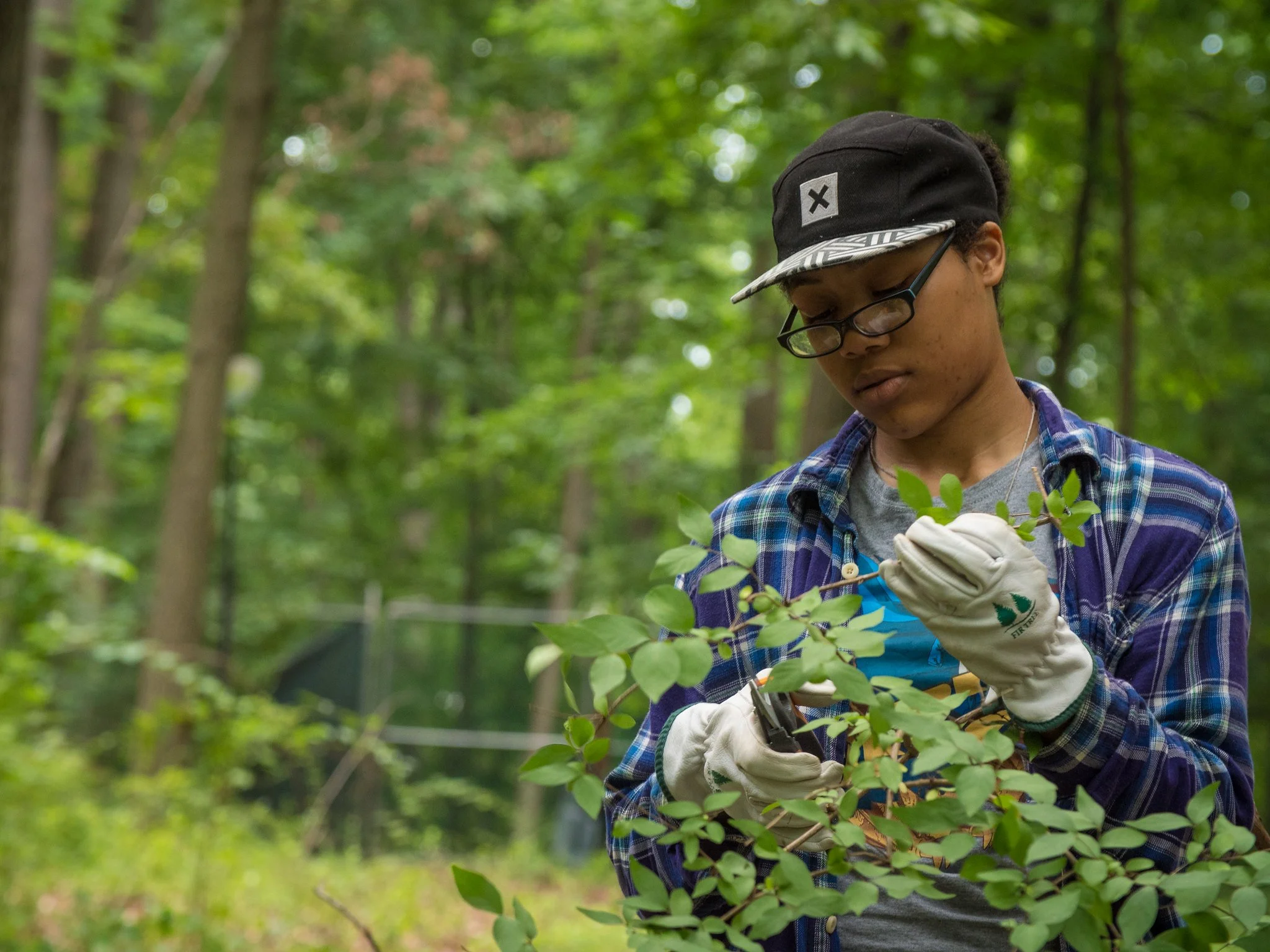
weed warriors
Rock Creek's forests drive our quality of life - cooling and cleaning the air and serving as a major source of climate and social resilience. A major threat to these fragile forests is the proliferation of invasive plants. Rock Creek stewards can help ensure the future resilience of Rock Creek's forests by becoming a Weed Warrior.
Weed Warriors are specialized volunteers who are granted permits through the National Park Service to remove invasive plants in designated areas of Rock Creek Park. Rock Creek Conservancy provides Weed Warriors the training, tools, and support they need to become stewards of a specific patch of the park.
In addition, Weed Warriors may engage in additional training to become Weed Warrior Leaders, who can host their own volunteer events.
Prospective Weed Warriors
Weed Warrior training provides individuals with the knowledge, skills, and techniques to help us support management of invasive plants in our region. Certified Weed Warriors are allowed to work independently in Rock Creek Conservancy’s mini-oases. Weed Warriors are asked to complete at least 36 hours of service per year and must report data for the service they complete each month.
To become a certified Weed Warrior, individuals must:
Be 18 years or older
Attend the Part 1 virtual training
Attend the Part 2 in-person training
Attend a site visit at an assigned Conservancy mini-oasis
Upcoming Trainings:
Spring 2025
Part 1 (virtual): May 14, 5:30 pm to 8:00 pm - REGISTRATION FULL
Part 2 (in-person): May 17, 9 am to 12:00 pm - REGISTRATION FULL
Site Visit (in-person): You will receive an email to register for a site visit after registering for Part 1 and Part 2.
Fall 2025
Part 1 (virtual): September 17, 5:30 pm to 8:00 pm - REGISTER HERE
Part 2 (in-person): September 20, 9:00 am to 12:00 pm - REGISTER HERE
Site Visit (in-person): You will receive an email to register for a site visit after registering for Part 1 and Part 2.
Current Weed Warriors
Reporting Your Independent Invasive Removal Work
Weed Warriors are asked to complete at least 36 hours of service per year and must report data for the service they complete each month. If you have conducted independent invasive removal work in the Conservancy's mini-oases, please complete the form linked below.
Note: You do not need to submit this form for work completed during a public event. The event leader submits a report for that event separately.
If you have conducted work outside of the Conservancy's mini-oases but within Rock Creek Park, use the NPS form here.
Weekly Office Hours
Rock Creek Conservancy and the National Park Service hosts virtual office hours every Thursday from 4PM to 5PM. Attend this optional meeting to hear updates from the Conservancy and NPS, ask questions, share success stories, meet other Weed Warriors, and more. Contact volunteer@rockcreekconservancy.org for the meeting link.
Interested in Becoming a Weed Warrior Leader?
Weed Warrior Leaders have the ability to host their own volunteer events. Contact us at volunteer@rockcreekconservancy.org to get started. Individuals interested in becoming Weed Warrior Leaders must:
Be a certified Weed Warrior
Attend a virtual Event Leadership Training
Complete 21 hours of shadowing Conservancy staff and Weed Warrior Leaders
Frequently Asked Questions
Where can I remove invasive plants?
Individuals are not permitted to remove invasive plants unless they are certified Weed Warriors. Rock Creek Conservancy is looking for Weed Warriors to serve in our mini-oases. Individuals who complete Weed Warrior training become certified Weed Warriors and get assigned a mini-oasis in which they will be permitted to remove invasives.
Working in the mini-oases offers individuals the opportunity to work alongside other Weed Warriors and through people-powered restoration, contribute to our goal of removing invasives to <5% cover in these areas.
Public volunteer events are regularly held across our mini-oases. Please join us at an event if you are interested in seeing these sites with a trained event leader.
What if I don’t want to make an ongoing commitment?
Join us at upcoming public volunteer events that meet your schedule.
Can I become a Weed Warrior in Montgomery County?
Yes, there is a Weed Warrior program for Montgomery County conducted by Montgomery Parks. Click here for more information.
What is an invasive plant?
An invasive non-native species is anything that is not native to an area (meaning it does not predate human colonization) that causes – or is likely to cause – harm to human health, the economy, or the environment. Invasive plants are plants that have been introduced to a new geographic area, whether this introduction was intentional or accidental. Examples of common invasive plants include:
English ivy
(Hedera helix)
japanese stiltgrass
(Microstegium vimineum)
Burning bush
(Euonymus alatus)
What is the impact of invasive plants in Rock Creek Park?
Invasive plants outcompete native plants for resources like sun, water, and soil. Native plants are necessary to support the complex community of native fauna in the park, from large mammals like coyotes, to migratory birds passing through each spring and fall. A tremendous diversity of insects also directly rely on these plants for habitat. Plant invasions lead to a decline in biodiversity across all types of life, starting with plants as the foundation of the food web, and cascading across the community.
For instance:
English ivy (Hedera helix) smothers the ground, preventing other plants such as spring ephemeral wildflowers, from growing. As it grows up trees, its weight can make trees more likely to fall during heavy storms.
Garlic mustard (Alliaria petiolata) is an allelopathic plant, meaning that it releases chemicals into the soil that make that soil unsuitable for the growth of other plants.
Few birds are able to nest in the branching structure of bush honeysuckle (Lonicera maackii), but those that do face increased exposure to predators.
Are all non-native species invasive?
Not all non-native, introduced species become invasive. However, those that do are typically characterized by fast growth, high rates of reproduction and dispersal, tolerance to a wide range of conditions, and a lack of natural predators to help control their populations. These traits can be applied to many non-native plant species introduced for landscaping, which can become invasive when they spread from managed landscapes into natural areas.
Help Support Weed Wrangle
Each year, Weed Warriors help support the annual National Capital Region Weed Wrangle from mid-September to mid-October. The National Capital Weed Wrangle is an area-wide volunteer-powered effort to protect our natural areas through removal of invasive plant species.






